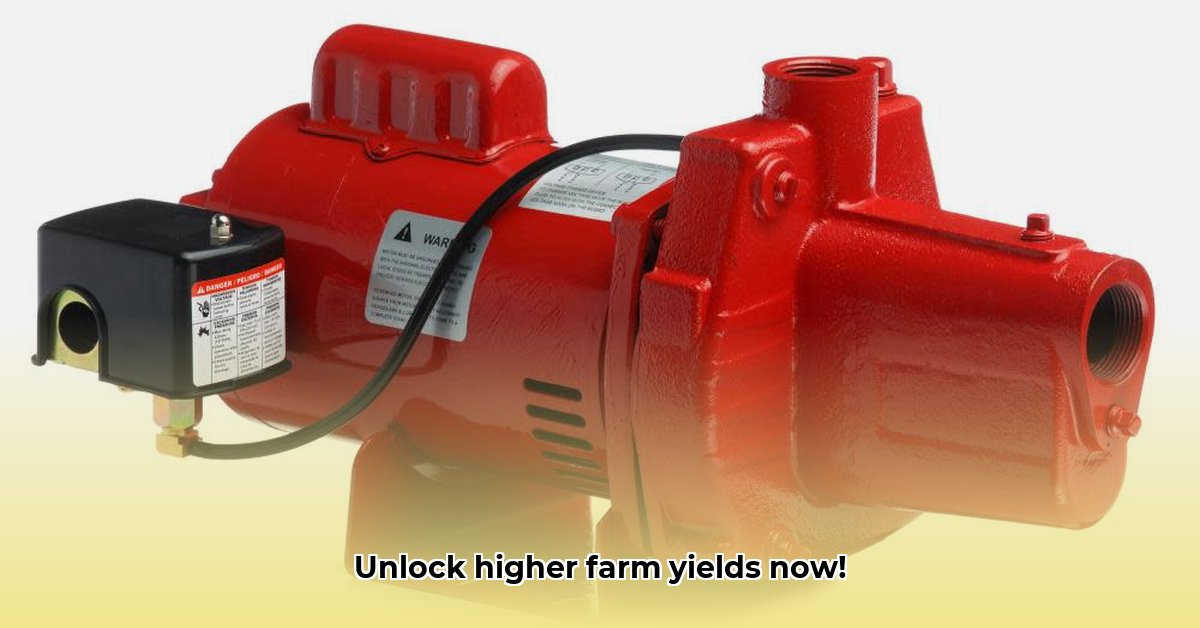
Jet Pump Tractor Supply: Maximizing Your Farm's Water Resources
Water is vital for thriving crops, and efficient irrigation is key to maximizing your yield. Jet pumps, readily available at most farm supply stores, offer a practical and often cost-effective irrigation solution for many farmers. But are they the right choice for your farm? This guide will help you decide. Have you considered the long-term cost-effectiveness of different irrigation methods? A comprehensive analysis is crucial for sustainable farming.
Understanding Jet Pumps: The Simple Truth
Jet pumps are centrifugal pumps utilizing the venturi effect (water squeezed through a narrower pipe to create suction). Think of it as a powerful siphon, drawing water from a source. Their relatively simple design typically requires minimal upkeep.
When are Jet Pumps a Perfect Fit?
Jet pumps excel in specific situations. They are ideal for shallow wells (typically under 25 feet deep) and smaller farms on tighter budgets, due to their affordability. A variety of options are available, offering different flow rates and power sources to match your needs.
However, jet pumps aren't a one-size-fits-all solution. For deep wells or high-volume water needs, other pump systems are more efficient. Similarly, if your water source is highly sedimented, a jet pump might experience premature wear. The abrasive particles can damage internal components, leading to reduced lifespan and higher repair costs.
Choosing the Right Jet Pump: A Step-by-Step Guide
Selecting the right jet pump requires careful planning. This step-by-step guide will help you make the best choice for your farm:
Assess Your Water Source: Determine the depth of your well or water source. Jet pumps have a limited lift capacity; accurate measurement is crucial.
Calculate Your Water Needs: Evaluate your acreage and the water requirements of your crops to determine the necessary gallons per minute (GPM) flow rate. Accurate estimation prevents water waste or crop stress.
Select Your Power Source: Choose between electricity or a gas engine, ensuring compatibility with your existing power supply. Compare the running costs of electricity versus gasoline.
Analyze Pump Specifications: Pay close attention to the pump's "head" (the height it can lift water) and flow rate (GPM). These specifications must align with your needs.
Prioritize Proper Installation: While jet pumps are relatively easy to install, proper setup is vital for optimal performance and longevity. Professional installation can prevent decreased efficiency and potential damage.
Jet Pumps: Weighing the Pros and Cons
The following table summarizes the advantages and disadvantages of jet pumps:
| Feature | Advantages | Disadvantages |
|---|---|---|
| Cost | Generally less expensive upfront than many other pump options. | Initial cost can still be a significant investment for some small farms. |
| Installation | Usually simpler to install than more complex pump systems. | Requires careful setup; mistakes can significantly impact performance. |
| Maintenance | Typically requires minimal ongoing maintenance. | Periodic checks and cleaning are necessary; parts might need replacing over time. |
| Water Source | Well-suited to shallow wells. | Not ideal for deep wells or situations with low water pressure. |
Jet Pumps and Sustainable Farming Practices
Efficient jet pump usage contributes to water conservation, a cornerstone of sustainable agriculture. Precise irrigation minimizes waste, making it a more environmentally friendly option than less efficient systems. However, regular maintenance is crucial for extending lifespan and reducing your overall environmental impact. “Regular maintenance is key to maximizing the lifespan and efficiency of any jet pump, reducing the environmental footprint through minimized replacements,” says Dr. Emily Carter, Agricultural Engineer at the University of California, Davis.
How to Compare Jet Pump Efficiency with Other Sustainable Irrigation Solutions
Choosing the right irrigation pump requires careful consideration of various factors beyond initial cost. This section compares jet pumps with other sustainable options. How do you balance upfront investment with long-term operating costs?
Understanding Jet Pump Mechanics
Jet pumps, while simple, can be less energy-efficient compared to alternatives like centrifugal pumps. This impacts the overall sustainability of your farming operation.
Comparing Jet Pumps to Other Sustainable Irrigation Technologies
A comparative table helps evaluate different irrigation technologies:
| Feature | Jet Pump | Centrifugal Pump | Drip Irrigation |
|---|---|---|---|
| Initial Cost | Low | Medium to High | Medium to High |
| Energy Efficiency | Low | High | High (if using efficient pump) |
| Maintenance | Low | Medium | Low to Medium |
| Water Use | Varies (depends on system) | Varies (depends on system) | Highly Efficient |
| Upfront Setup | Simpler | More complex installation | More complex installation and design |
Key Takeaways:
- Jet pumps offer simplicity and reliability but are less energy-efficient.
- Comparing jet pump efficiency requires a lifecycle cost analysis, accounting for initial costs and long-term expenses.
- Consider water source characteristics and infrastructure compatibility.
- Sustainable water management involves choosing the most efficient irrigation method suited to your specific needs.
Remember to consult with agricultural experts for personalized advice. With careful planning and the right equipment, you can optimize water usage, increase yields, and build a more sustainable farming operation.